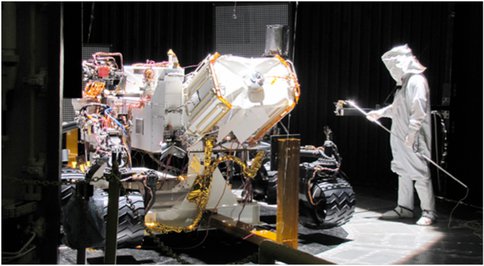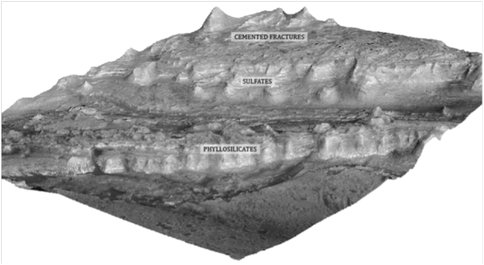2011 Annual Science Report
 Massachusetts Institute of Technology
Reporting | SEP 2010 – AUG 2011
Massachusetts Institute of Technology
Reporting | SEP 2010 – AUG 2011
Astrobiological Exploration of Mars
Project Summary
The Mars Science Laboratory (MSL) mission, due for launch in November 25th, 2011, has four primary science objectives for looking at habitable environments: assess the biological potential of at least one target environment by determining the nature and inventory of organic carbon compounds; characterize the geology of the landing region at all appropriate spatial scales by investigating the chemical, isotopic, and mineralogical composition of the surface and near-surface materials; investigate planetary processes of relevance to past habitability, including the role of water and carbon dioxide; and characterize the broad spectrum of surface radiation. Project scientist John Grotzinger and other MIT NAI team members have been contributing to numerous aspects of site selection, site evaluation and the optimal Mars environments for biosignature formation and preservation.
Project Progress
Mars Science Laboratory: John Grotzinger and Jennifer Griffes
The Mars Science Laboratory (MSL) mission has four primary science objectives for looking at habitable environments: assess the biological potential of at least one target environment by determining the nature and inventory of organic carbon compounds; characterize the geology of the landing region at all appropriate spatial scales by investigating the chemical, isotopic, and mineralogical composition of the surface and near-surface materials; investigate planetary processes of relevance to past habitability, including the role of water and carbon dioxide; and characterize the broad spectrum of surface radiation (MSL website; Fig. 1). MSL is not a life-detection mission, but it will be able to detect complex organic molecules in rocks and soils, which could be of biological origin, or from carbonaceous meteorites (Grotzinger, 2009).
At Caltech, MSL Project Scientist John Grotzinger, staff scientist Jennifer Griffes, and graduate student Katie Stack, have all been working on landing site selection this past year. In May 2011, the 5th community landing site workshop was held in Monrovia, CA, where the focus was on unresolved scientific uncertainties for the four remaining potential landing sites, as well as analysis of landing site safety and traversability. After a series of discussions and meetings over the summer, Gale crater was chosen as a landing site for MSL. Gale has a diverse stratigraphy within a 5 km high central mound in the crater. There are well-defined beds of hydrated minerals including sulfates and phyllosilicates, some of which are interbedded. This could represent changing environmental conditions during deposition. Discussions of past environmental conditions on Mars brings into context important concepts of astrobiology including what is known about the capacity of life, as we know it, to exist in Martian environments. Slightly higher in the lower mound, there are cemented fractures (Fig 2), evidence that there was once groundwater to at least that height on the mound. Within the landing ellipse, there are variations in thermal inertia, including a high thermal inertia fan sourced from the crater rim.
Since the landing site has been chosen, John Grotzinger and Jennifer Griffes have been involved in the Gale Imaging Working Group, which has been identifying key HiRISE and CRISM data products, which could enhance our science mission at Gale crater. The goal is targeting data in the ellipse and on the lower mound (where the rover would traverse; Fig 3), in order to create high resolution digital elevation models (DEMs) and super high resolution CRISM mineralogical data. This will be used for science analysis and traversability studies.
During this time, the rover is in Cape Canaveral, currently being encapsulated into the rocket. The launch window opens November 25, 2011.
John Grotzinger, Jennifer Griffes and Katie Stack have also done outreach talks this year at various universities and grade schools focused on Mars exploration. By promoting science education, we are getting the community excited about future Mars missions.
Crater Counting in Gale Crater: Undergraduate student Kenzie Day
One of the astrobiological goals of Mars Science Laboratory is to explore materials that may be as little altered as possible by background solar and cosmic radiation. Fresh craters provide ejecta that represents windows into the parts of rocks volumes that are least altered or unaltered by radiation damage. Thus, Kenzie Day – a Caltech undergraduate student – conducted a search for fresh craters at the Gale landing site.
In this study Kenzie looked at the distribution of small craters in Gale to create a crater-based geologic map for comparison with the existing map of Anderson, 2010. Additionally, she made estimates of the ages of the different units. Using typical terrains in six geologic units of interest, she measured the density of craters in number per kilometer, and plotted these densities on isochrones derived from moon cratering rates presented in Smith 2008. The isochrones are only accurate to craters of 4 m or greater in diameter, so the density measurements are of craters from 4 to 500 meters.
After plotting the data on isochrones, she attempted to determine the ages of the surfaces. By converting individual density measurements into ages, and then taking the average of these for a given unit, she created Figure 4, a plot of the relative ages of each of the units. Error bars indicate the uncertainty calculated by taking the square root of the number counted divided by the area covered to get a “density error.”
Kenzie subdivided the alluvial fan into its low and high thermal inertia components. We were interested to see how these two fans evolved with respect to the surrounding cratered plain. Initial results suggested that the fan was older than the surrounding plain, which counters the intuitive stratigraphic relationship. At first glance the fan seems to have formed on top of the plain, making its higher age estimate suspect. We took a closer look at these three units, the two fans and the plains, and determined that within the error of the analysis, the ages were roughly equivalent. The fan may have formed earlier or later than the plain, but in either case, the time difference was small. We concluded that the three surfaces coevolved approximately 100 million years ago. Highly degraded craters are ubiquitous in this region of mars, particularly at the 5-20 m scale, which adds considerable error when constraining the age of a surface in the landing ellipse. However, our calculations of the unit ages are at least a lower bound on the correct age of the surfaces.
Team member Andrew Knoll continues his work as a member of the science team for NASA’s MER rover mission to Mars. Knoll contributed actively to a team paper summarizing new discoveries in 2009 and 2010 (Arvidson et al., 2011).
Summons and Knoll also contributed to a group effort aimed at defining the conditions under which MSL’s Sam instrument package is likely to be most effective at detecting biosignatures. This work includes an analysis of where biosigaturesd are most readily formed and where they are most likely to be preserved ( ie taphonomic wondows).
Knoll and Grotzinger (with others) have begun to work on a paper that will integrate the growing inventory of remotely sensed data on clay minerals exposed at the martian surface with equally fast growing information on sedimentary accumulations on Mars and the geologic processes that influence clay mineral composition on Earth.
Mars Astrobiology Figure 1. MSL in the space simulation chamber at JPL. Photo credit: NASA/JPL
Mars Astrobiology Fig 2. Cemented fractures in Gale crater
Mars Astrobiology Figure 2. Digital elevation model of lower mound of Gale crater at 3x vertical exaggeration.
Mars Astrobiology Figure 4. Average ages of the six Gale Crater geologic units of interest
Publications
-
Arvidson, R. E., Ashley, J. W., Bell, J. F., Chojnacki, M., Cohen, J., Economou, T. E., … Wolff, M. J. (2011). Opportunity Mars Rover mission: Overview and selected results from Purgatory ripple to traverses to Endeavour crater. Journal of Geophysical Research, 116. doi:10.1029/2010je003746
-
Summons, R. E., Amend, J. P., Bish, D., Buick, R., Cody, G. D., Des Marais, D. J., … Sumner, D. Y. (2011). Preservation of Martian Organic and Environmental Records: Final Report of the Mars Biosignature Working Group. Astrobiology, 11(2), 157–181. doi:10.1089/ast.2010.0506
- Grotzinger, J.P. & Milliken, R.E. (2011, In Press). The Sedimentary Rock Record of Mars: Distribution, Origins, and Global Stratigraphy. In: Grotzinger, J.P.a.M. & R., E. (Eds.). Sedimentary Geology of Mars. SEPM Special Publication.
-
PROJECT INVESTIGATORS:
-
PROJECT MEMBERS:
Nicholas Tosca
Postdoc
Jeniffer Griffes
Research Staff
Kathryn Stack
Doctoral Student
Joannah Metz
Graduate Student
Mackenzie Day
Undergraduate Student
-
RELATED OBJECTIVES:
Objective 1.1
Formation and evolution of habitable planets.
Objective 2.1
Mars exploration.






